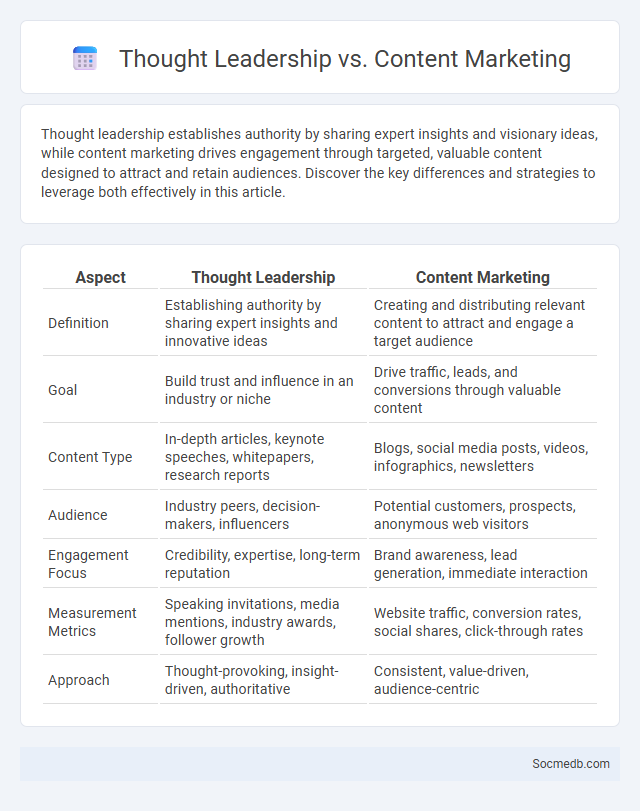
Photo illustration: Thought Leadership vs Content Marketing
Thought leadership establishes authority by sharing expert insights and visionary ideas, while content marketing drives engagement through targeted, valuable content designed to attract and retain audiences. Discover the key differences and strategies to leverage both effectively in this article.
Table of Comparison
| Aspect | Thought Leadership | Content Marketing |
|---|---|---|
| Definition | Establishing authority by sharing expert insights and innovative ideas | Creating and distributing relevant content to attract and engage a target audience |
| Goal | Build trust and influence in an industry or niche | Drive traffic, leads, and conversions through valuable content |
| Content Type | In-depth articles, keynote speeches, whitepapers, research reports | Blogs, social media posts, videos, infographics, newsletters |
| Audience | Industry peers, decision-makers, influencers | Potential customers, prospects, anonymous web visitors |
| Engagement Focus | Credibility, expertise, long-term reputation | Brand awareness, lead generation, immediate interaction |
| Measurement Metrics | Speaking invitations, media mentions, industry awards, follower growth | Website traffic, conversion rates, social shares, click-through rates |
| Approach | Thought-provoking, insight-driven, authoritative | Consistent, value-driven, audience-centric |
Defining Thought Leadership
Thought leadership on social media establishes you as an expert by consistently sharing valuable insights and original ideas that resonate with your target audience. Building trust and credibility through authentic engagement and well-informed content positions your brand as a go-to resource within your industry. Leveraging platforms like LinkedIn, Twitter, and Instagram amplifies your influence and fosters meaningful professional connections.
Understanding Content Marketing
Understanding content marketing on social media involves creating valuable, relevant content tailored to your target audience's interests and needs. Effective content marketing leverages platforms like Facebook, Instagram, and LinkedIn to increase brand awareness, engage users, and drive conversions. By analyzing audience behavior and optimizing posts for each channel, you can enhance your social media strategy and achieve your marketing goals.
Key Differences: Thought Leadership vs Content Marketing
Thought leadership centers on establishing authority and expertise by sharing original insights and visionary ideas that influence industry perspectives. Content marketing focuses on creating and distributing valuable, relevant content to attract and engage a targeted audience while driving specific business goals. Social media amplifies both strategies, with thought leadership fostering trust and credibility, whereas content marketing boosts brand awareness and customer acquisition.
Strategic Goals Compared
Strategic goals in social media focus on enhancing brand awareness, driving customer engagement, and increasing sales conversions through targeted content and analytics. You should prioritize measurable objectives such as follower growth, click-through rates, and audience sentiment analysis to track success effectively. Understanding these goals helps tailor your campaigns for maximum impact within competitive digital environments.
Audience Engagement Approaches
Effective audience engagement approaches on social media include leveraging interactive content like polls, quizzes, and live videos to foster real-time participation. Tailoring posts to resonate with your target demographic through personalized messaging increases relevance and encourages shares and comments. Consistent responsiveness to user interactions strengthens community trust and builds long-term loyalty for your brand.
Measuring Success in Both Strategies
Measuring success in social media strategies involves tracking key performance indicators such as engagement rates, conversion rates, and follower growth across platforms like Instagram, Facebook, and Twitter. Utilizing analytics tools like Google Analytics and native social media insights helps quantify the effectiveness of paid advertising campaigns versus organic content strategies. Consistent monitoring of metrics like click-through rates, impressions, and audience demographics enables marketers to optimize content and maximize return on investment.
Creating Impactful Thought Leadership Content
Creating impactful thought leadership content on social media requires deep expertise and authentic insights that resonate with your target audience. Your content should provide unique perspectives and actionable advice, establishing you as a credible authority in your industry. Consistently engaging with followers and leveraging relevant hashtags enhances visibility and drives meaningful conversations around your expertise.
Integrating Thought Leadership and Content Marketing
Integrating thought leadership with content marketing enhances brand authority by delivering insightful, data-driven narratives that resonate with target audiences. Consistently publishing original research, expert opinions, and innovative ideas across social media platforms fosters trust and encourages meaningful engagement. Leveraging analytics to tailor content distribution ensures maximum reach and impact, positioning the brand as an industry pioneer.
Common Pitfalls to Avoid
Social media pitfalls include oversharing personal information, which can compromise your privacy and security, and neglecting consistent interaction with your audience, leading to reduced engagement. Another common error is failing to tailor content to platform-specific audiences, causing diminished reach and relevance. Being aware of these challenges helps you maintain a strong, trustworthy online presence.
Choosing the Right Approach for Your Brand
Choosing the right social media approach for your brand involves analyzing target audience demographics, platform functionalities, and content styles that resonate with your market. Tailoring your strategy to specific channels like Instagram for visuals, LinkedIn for professional networking, or TikTok for viral engagement enhances brand visibility and user interaction. Understanding these factors empowers you to create compelling content that aligns with your brand identity and achieves measurable business goals.
 socmedb.com
socmedb.com